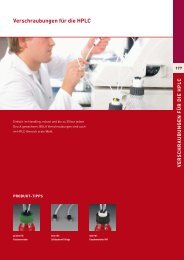- Page 3 and 4: ContentsObsahSachregisterContenuCon
- Page 5: MECHANICAL STABILITY OF SIMAX GLASS
- Page 10 and 11: MECHANICká STálost SKLa SIMAXMech
- Page 12 and 13: Chemická odolnost materiálůSkupi
- Page 14 and 15: SIMAX-GLASDie Glashütte KAVALIER w
- Page 16 and 17: LichtdurchlässigkeitSpektrale Durc
- Page 18 and 19: Laborflaschen SIMAXDie Laborflasche
- Page 20 and 21: STABILITE MECANIQUE DU VERRE SIMAXL
- Page 22 and 23: Plastiques utilisés avec le verre
- Page 24 and 25: VIDRIO SIMAXLas vidrierías KAVALIE
- Page 26 and 27: Propiedades ópticas del vidrio SIM
- Page 28 and 29: 2. Instrucciones de seguridad para
- Page 30 and 31: Beakers, low form, with spoutKádin
- Page 32 and 33: Crystallising dishes without spoutM
- Page 34 and 35: Flasks Erlenmeyer, narrow neckBaňk
- Page 36 and 37: Flasks, round bottom, narrow neck,
- Page 38 and 39: Cat. No. 2205Boxes with drop - on c
- Page 40 and 41: Bottles weighing,with ground - in s
- Page 42 and 43: Bell jars with ground flange and ne
- Page 44 and 45: Bottles Woulff, three necks and out
- Page 46 and 47: Bottles gas washing, DrechslerProm
- Page 48 and 49: Reverse valve, straightVentil zpět
- Page 50 and 51: Cat. No.7365Pipette automat. Kipp w
- Page 52 and 53: Reagent bottles with screw GL 45 ac
- Page 54 and 55: Silicon gasket with PTFE coatedTěs
- Page 57 and 58:
3) DessicatorsExsikátoryExsikkator
- Page 59 and 60:
Desiccator with tubes (outlet) ands
- Page 61 and 62:
Cat. No. 262 KDesiccator´s lid wit
- Page 63 and 64:
4) Volumetric glasswareOdměrné sk
- Page 65 and 66:
Flasks volumetric with SJand glass
- Page 67 and 68:
Flasks volumetric brown with SJand
- Page 69 and 70:
Flasks volumetric with SJand plasti
- Page 71 and 72:
Flasks with divided neckBaňka s d
- Page 73 and 74:
Cylinders graduated with hexagonal
- Page 75 and 76:
Cylinders graduated with hexagonal
- Page 77 and 78:
Cylinders with hexagonal base, high
- Page 79 and 80:
Cylinders with hexagonal base, high
- Page 81 and 82:
Cat. No. 1581 BLTitration apparatus
- Page 83:
Measures graduated, cylindrical for
- Page 86 and 87:
Funnels plain, angle 60°, short st
- Page 88 and 89:
Flask filtering with plastic side h
- Page 90 and 91:
Crucibles, gooch type, conical form
- Page 92 and 93:
Funnels separatory, cylindrical, op
- Page 94 and 95:
Funnel separatory cylindrical with
- Page 97 and 98:
6) Glassware with SJVýrobky se zá
- Page 99 and 100:
Cat. No.8003Flasks with flat bottom
- Page 101 and 102:
Cat. No. 8027Cat. No.8029Flasks hea
- Page 103 and 104:
Standard joint, coneNZ jádroNormsc
- Page 105 and 106:
Joint (adapter) SJ - GLSpojka (redu
- Page 107 and 108:
Bend recovery, sloping, angle 75°,
- Page 109 and 110:
Adapter to rinse SJ 29/32 with rubb
- Page 111 and 112:
Stopcock, T - boreKohout trojcestn
- Page 113 and 114:
Stopper octagonal, SJZátka osmihra
- Page 115 and 116:
7) Glass apparatusLaboratorní př
- Page 117 and 118:
Condenser Liebig with SJ coneChladi
- Page 119 and 120:
Condenser, Allihn, SJ cone and sock
- Page 121 and 122:
Cat. No.8282Condenser, Dimroth, ref
- Page 123 and 124:
Cat. No. 8757 BApparatus Impinger 5
- Page 125 and 126:
Condenser, redistilling, multi - co
- Page 127 and 128:
Manometer gauges, with scale, witho
- Page 129 and 130:
8) Glassware for microbiologyMikrob
- Page 131 and 132:
Culture flasks Roux, central neckBa
- Page 133 and 134:
9) TestubesZkumavkyReagenzgläserTu
- Page 135 and 136:
Test tubes without rim, round botto
- Page 137 and 138:
Cat. No.3830Test tubes with round b
- Page 139 and 140:
10) Laboratory appliances, burnersL
- Page 141 and 142:
Code ∅ l600000 mm mm396 551 310 1
- Page 143 and 144:
Universal stand BunsenThe universal
- Page 145 and 146:
Hofman hose clampHofmanova tlačkaH
- Page 147 and 148:
CodeTypeGasPlynGasGasGazLaboratory
- Page 149 and 150:
11) Labortaory accesoriesand equipm
- Page 151 and 152:
Code600000632 612 009 007632 612 00
- Page 153 and 154:
Electric bath EL - 20 DThe apparatu
- Page 155 and 156:
Labor-Schüttelapparat LT 3Der Labo
- Page 157 and 158:
ALPHABETICAL INDEX BY NAMEAAdapter
- Page 159 and 160:
Abecední index podle názvuBBaňka
- Page 161 and 162:
SACH- UND NAMENS-VERZEICHNISAAbdamp
- Page 163 and 164:
INDEX ALPHABÉTIQUE ET RÉPERTOIRE
- Page 165 and 166:
INDICE POR NOMBRES Y MATERIASAAbraz
- Page 167 and 168:
Index by catalogue numberIndex podl




